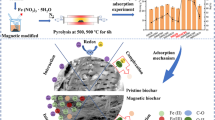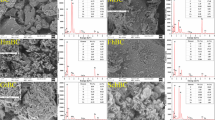Abstract
In the present study, a series of regeneration conditions and the regeneration mechanism of modified lake sediment biochar (Fe-KOH/LSB) catalysts for low-temperature catalytic hydrolysis of carbon disulfide (CS2) were investigated. The results showed that Rm-WNA method had the best regeneration effect. Under optimal regeneration conditions, the sulfur capacity (13.86 mg[S]/g[catalyst]) of regenerated Fe- KOH/LSB was close to that of fresh Fe-KOH/LSB (14.88 mg[S]/g[catalyst]). The water washing process could wash away a small number of sulfates and a large number of alkaline groups. TG-DTA and DRTFIR results indicated that the nitrogen sweeping process could decompose Fe2(SO4)3 into Fe2O3, which partially recovered the catalytic and the adsorptive abilities. CO2-TPD results indicated that the alkali steeping process offer -OH groups, further improving the catalytic and the adsorptive abilities. After 3 times-regeneration, the sulfur capacity of Fe-KOH/LSB reached 13.31 mg[S]/g[catalyst], indicating that the Rm-WNA method had good stability for the recovery of the catalytic activity. BET, XPS and XRD results revealed that the decrease of the sulfur capacity for regeneration was attributed to the decrease of the adsorptive abilities of C and SiO2.
Similar content being viewed by others
References
Wu Z, Wang S. Release mechanism and kinetic exchange for phosphorus (P) in lake sediment characterized by diffusive gradients in thin films (DGT). Journal of Hazardous Materials, 2017, 331: 36–44
Wu X, Wang C, Tian C, et al. Evaluation of the potential of anoxic biodegradation of intracellular and dissolved microcystins in lake sediments. Journal of Hazardous Materials, 2015, 286: 395–401
Song X, Ning P, Wang C, et al. Research on the low temperature catalytic hydrolysis of COS and CS2 over walnut shell biochar modified by Fe–Cu mixed metal oxides and basic functional groups. Chemical Engineering Journal, 2017, 314: 418–433
He D, Yi H, Tang X, et al. The catalytic hydrolysis of carbon disulfide on Fe–Cu–Ni/AC catalyst at low temperature. Journal of Molecular Catalysis A: Chemical, 2012, 357: 44–49
Li K, Song X, Ning P, et al. Energy utilization of yellow phosphorus tail gas: simultaneous catalytic hydrolysis of carbonyl sulfide and carbon disulfide at low temperature. Energy Techno-logy, 2015, 3(2): 136–144
Huang H, Young N, Williams B P, et al. High temperature COS hydrolysis catalysed by γ-Al2O3. Catalysis Letters, 2006, 110(3–4): 243–246
Liu Y, He H, Ma Q. Temperature dependence of the heterogeneous reaction of carbonyl sulfide on magnesium oxide. The Journal of Physical Chemistry A, 2008, 112(13): 2820–2826
Ning P, Yu L, Yi H, et al. Effect of Fe/Cu/Ce loading on the coalbased activated carbons for hydrolysis of carbonyl sulfide. Journal of Rare Earths, 2010, 28(2): 205–210
Li Q, Yi H, Tang X, et al. Preparation and characterization of Cu/Ni/Fe hydrotalcite-derived compounds as catalysts for the hydrolysis of carbon disulfide. Chemical Engineering Journal, 2016, 284: 103–111
Sun X, Ning P, Tang X, et al. Simultaneous catalytic hydrolysis of carbonyl sulfide and carbon disulfide over Al2O3-K/CAC catalyst at low temperature. Journal of Energy Chemistry, 2014, 23(2): 221–226
Fan L, Chen J, Guo J, et al. Influence of manganese, iron and pyrolusite blending on the physiochemical properties and desulfurization activities of activated carbons from walnut shell. Journal of Analytical and Applied Pyrolysis, 2013, 104: 353–360
Ning P, Li K, Yi H, et al. Simultaneous catalytic hydrolysis of carbonyl sulfide and carbon disulfide over modified microwave coal-based active carbon catalysts at low temperature. The Journal of Physical Chemistry C, 2012, 116(32): 17055–17062
Rhodes C, Riddel S A, West J, et al. The low-temperature hydrolysis of carbonyl sulfide and carbon disulfide: a review. Catalysis Today, 2000, 59(3–4): 443–464
Yegiazarov Y, Clark J, Potapova L, et al. Adsorption-catalytic process for carbon disulfide removal from air. Catalysis Today, 2005, 102–103: 242–247
Tsybulevskii A M, Kapustin G I, Brueva T R, et al. The nature of activity of the alumina catalysts in the reaction of carbon disulfide hydrolysis. Kinetics and Catalysis, 1998, 39: 130–136
Wang H, Yi H, Ning P, et al. Calcined hydrotalcite-like compounds as catalysts for hydrolysis carbonyl sulfide at low temperature. Chemical Engineering Journal, 2011, 166(1): 99–104
Sheintuch M, Matatov-Meytal Y I. Comparison of catalytic processes with other regeneration methods of activated carbon. Catalysis Today, 1999, 53(1): 73–80
Stawiński W, Węgrzyn A, Dańko T, et al. Acid-base treated vermiculite as high performance adsorbent: Insights into the mechanism of cationic dyes adsorption, regeneration, recyclability and stability studies. Chemosphere, 2017, 173: 107–115
Wilburn M S, Epling WS. Sulfur deactivation and regeneration of mono-and bimetallic Pd–Pt methane oxidation catalysts. Applied Catalysis B: Environmental, 2017, 206: 589–598
Sabio E, González E, González J F, et al. Thermal regeneration of activated carbon saturated with p-nitrophenol. Carbon, 2004, 42(11): 2285–2293
Yu T, Xu M, Huang Y, et al. Insight of platinum poisoning Cu/SAPO-34 during NH3-SCR and its promotion on catalysts regeneration after hydrothermal treatment. Applied Catalysis B: Environmental, 2017, 204: 525–536
Arosio F, Colussi S, Groppi G, et al. Regeneration of S-poisoned Pd/Al2O3 catalysts for the combustion of methane. Catalysis Today, 2006, 117(4): 569–576
Wang M, Li G, Huang L, et al. Study of ciprofloxacin adsorption and regeneration of activated carbon prepared from Enteromorpha prolifera impregnated with H3PO4 and sodium benzenesulfonate. Ecotoxicology and Environmental Safety, 2017, 139: 36–42
Do M H, Phan N H, Nguyen T D, et al. Activated carbon/Fe3O4 nanoparticle composite: fabrication, methyl orange removal and regeneration by hydrogen peroxide. Chemosphere, 2011, 85(8): 1269–1276
Pan H, Jian Y, Yu Y, et al. Regeneration and sulfur poisoning behavior of In/H-BEA catalyst for NOx reduction by CH4. Applied Surface Science, 2017, 401: 120–126
Dai Y D, Yuan C, Huang C P, et al. Regeneration of spent carbon nanotubes by electrochemical oxidation over RuO2/Ti electrode. Separation and Purification Technology, 2017, 178: 207–214
He X, Elkouz M, Inyang M, et al. Ozone regeneration of granular activated carbon for trihalomethane control. Journal of Hazardous Materials, 2017, 326: 101–109
Xia S, Nie R, Lu X, et al. Hydrogenolysis of glycerol over Cu0.4/Zn5.6–xMgxAl2O8.6 catalysts: The role of basicity and hydrogen spillover. Journal of Catalysis, 2012, 296: 1–11
Hou Z, Yashima T. Meso-porous Ni/Mg/Al catalysts for methane reforming with CO2. Applied Catalysis A: General, 2004, 261(2): 205–209
Gao J, Hou Z, Guo J, et al. Catalytic conversion of methane and CO2 to synthesis gas over a La2O3-modified SiO2 supported Ni catalyst in fluidized-bed reactor. Catalysis Today, 2008, 131(1–4): 278–284
Yuan Z, Wang L, Wang J, et al. Hydrogenolysis of glycerol over homogenously dispersed copper on solid base catalysts. Applied Catalysis B: Environmental, 2011, 101(3–4): 431–440
Valente J S, Pfeiffer H, Lima E, et al. Cyanoethylation of alcohols by activated Mg–Al layered double hydroxides: Influence of rehydration conditions and Mg/Al molar ratio on Brönsted basicity. Journal of Catalysis, 2011, 279(1): 196–204
Busca G. Bases and basic materials in chemical and environmental processes. Liquid versus solid basicity. Chemical Reviews, 2010, 110(4): 2217–2249
Acknowledgements
This work was supported by the National Key R&D Program of China (2018YFC0213400), the National Natural Science Foundation of China (Grant Nos. 51408282, 21667015 and 51708266), the China Scholarship Council (201508530017, 201608530169 and 201608740011), and the Analysis and Testing Foundation of Kunming University of Science and Technology.
Author information
Authors and Affiliations
Corresponding authors
Rights and permissions
About this article
Cite this article
Wang, C., Li, K., Sun, X. et al. Surface characteristics of regenerative Fe-KOH/LSB catalysts for low-temperature catalytic hydrolysis of carbon disulfide and research of the surface regeneration mechanism. Front. Mater. Sci. 12, 426–437 (2018). https://doi.org/10.1007/s11706-018-0440-1
Received:
Accepted:
Published:
Issue Date:
DOI: https://doi.org/10.1007/s11706-018-0440-1




